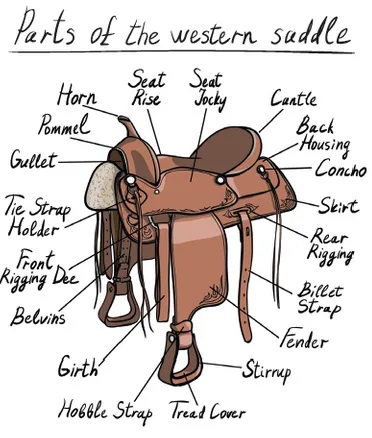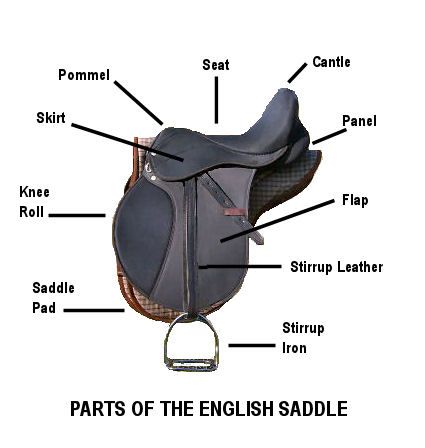What Are the Individual Parts of a Saddle?

The saddle is undoubtedly one of the most important pieces of horse riding equipment you’ll ever own. In fact, as long as you have a proper saddle and a decent set of reins, you’ll be able to ride your horse without too many issues. This is why I think it’s important to know as much as possible about the saddle, including its individual parts and sections.
What are the different parts of a saddle called? The saddle is composed of three different sections for starters: the pommel, seat, and cantle. To make things easier for you, you can imagine these represent the saddle’s front, middle, and rear sections. Each section usually includes a series of attachments such as stirrups, grab straps, the girth, and the breastplate.
Keep in mind that Western saddles are different than English saddles. Don’t worry as we’ll take a closer look at both types in this article.
The individual parts of a Western Saddle.

As you can see in the image above, the individual parts of a Western saddle are as follows:
- Horn
- Seat rise
- Seat jockey
- Cantle
- Back housing
- Concho
- Skirt
- Rear rigging
- Billet strap
- Fender
- Stirrup
- Tread cover
- Hobble strap
- Girth
- Belvins
- Front rigging dee
- Tie strap holder
- Gullet
- Pommel
The individual parts of an English saddle.

The English saddle is quite a bit different when compared to the Western saddle. However, the two saddle types do share some common elements. Here is a complete breakdown of the individual parts of an English Saddle:
- Pommel
- Seat
- Cantle
- Panel
- Flap
- Stirrup leather
- Stirrup iron
- Saddle pad
- Knee roll
- Skirt
The pommel.
One of the most important parts of the saddle is the pommel. This is also one of the most well-known sections, as it literarily sticks out into view in Western saddles. The pommel plays an important role: it helps the rider achieve a proper position in the seat.
Another thing you need to know about the pommel is that it should always clear a horse’s withers by a few inches. Furthermore, the pommel also comprises the saddle’s knee flaps or pads. These offer a convenient place for the rider to rest his knees.
The seat.
The seat is the most visible and well-worn part of a saddle. It also plays a key role when it comes to comfort. The seat is where you rest your bottom – it provides support and cushioning as you ride your horse. This section of a saddle is quite a bit wider than the pommel, and it attaches to the main flaps on either side of the saddle.
Whether we’re talking about Western riding or English riding, the saddle’s seat serves the same purpose. Its importance is often overlooked. It’s one of those things that we don’t pay attention to when everything goes well. If there’s something wrong with the seat, though, we definitely notice.
Flaps and billets.
Depending on your saddle type, it will typically have either two flaps or a single flap. In a dual-flap design, one of the flaps can be lifted up in order to access the billets. This is the area where you can attach the girth to the saddle.
With a single-flap design, the billets are attached at the bottom of the one flap. Saddles with mono-flaps require a shorter girth, which is attached to the billets below the flap.
The Cantle.
Also known as the rear of the saddle, the cantle slopes upward and provides a bit of extra support for the rider. In English riding, the type of cantle usually determines the type of saddle used for various activities. For instance, if the cantle is low, it ensures closer contact with the horse while riding. On the other hand, higher cantles offer a deeper seat.
It’s not at all uncommon for riders to adorn the saddle’s cantle with silver or brass nameplates.
Saddle attachments and what they’re used for.
Apart from the individual parts of the saddle itself, it can also pay off to know a thing or two about its attachments and their various functions. These include the breastplate, martingale, grab strap, croup strap, girth, stirrups, and stirrup leathers.
The breastplate.
What you need to keep in mind about the breastplate is that it serves a very simple and important purpose: it prevents the saddle from sliding backward. There are two main types of breastplates, namely three-point and five-point ones.
A three-point breastplate will attach to both sides of the pommel of the saddle and the girth. It attaches to the saddle at three points, hence the name. The eventing five-point breastplate uses the same points of contact as the three-point, but it also adds another two points at the billets.
Martingales.
What is the point of using martingales? Well, these saddle attachments limit the horse’s head movement by preventing it from throwing its head up too high. This is important, as this kind of behavior can prove dangerous for both the horse and the rider. Martingales attach to the horse’s girth, and they sit around the neck. There are two types of martingales, namely standing and running.
The running martingale has two straps that attach to the reins of the bridle, while the standing martingale attaches from the girth to the noseband of a horse’s bridle.
Grab straps and croup straps.
Depending on your saddle type, you might notice the presence of a few D-shaped rings. These were designed to help you attach either a grab strap or a croup strap to your saddle. Grab straps are made out of leather, and they’re relatively small when compared to other saddle attachments. They attach from one side of the pommel to the other, and they can help the rider regain his balance when things get rough in the saddle. Grab straps are often used in dressage, or in riding classes by young riders.
Croup straps link the cantle around a horse’s tail. Their purpose is to prevent the saddle from sliding up a horse’s neck. They serve the same purpose as a breastplate, but they prevent the saddle from sliding the other way.
The girth.
Even with all of these straps and attachments, a saddle would not sit properly on a horse without being attached around its belly. There are many different types of girths available, some minimalistic in nature while others serve a protective purpose. Girths can be made out of leather, cotton, rope, synthetic materials, or rubber.
Thinner girths used in the hunting ring are minimalistic and unobtrusive. On the other hand, leather girths sometimes cover the horse’s entire belly in order to ensure protection at jumping events. Sometimes, in order to avoid knocking off a rail, a jumping horse will kick itself in the belly. Leather girths help mitigate the impact and prevent injuries.
Stirrups.
When you ride your horse, you keep your feet in the stirrups. These saddle attachments are important for balance and proper posture while on horseback. Stirrups are made out of different materials such as metal and plastic. Their designs can include spikes for extra grip, or multiple joints for mobility.
In order to attach the stirrups to the saddle, you’ll need a series of stirrup straps/leathers. You’ll probably need to adjust these leathers depending on the size of your legs in order to achieve a comfortable seat in the saddle.
Summary.
Saddles are complex. They include different sections, each with its own attachments and unique purpose. In order to become better at horseback riding, it’s important to understand exactly how these parts work.
Hopefully, this article has helped you gain a better understanding of the individual parts of a saddle. If I missed something, or if you’d like me to add something to this article, don’t hesitate to get in touch.

